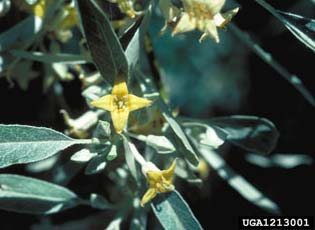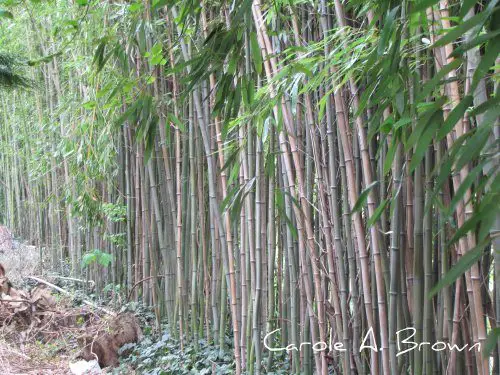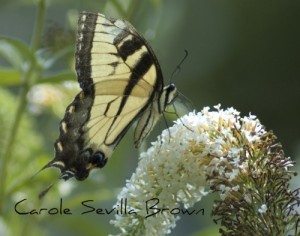
In this category, we focus on the dangers of using invasive plants in your wildlife garden. Invasive species can quickly take over native habitats and disrupt delicate ecosystems, causing harm to local wildlife and reducing biodiversity. We provide information on common invasive plants, as well as tips on how to identify and remove them from your garden. Whether you’re an experienced gardener or just starting out, this category has everything you need to know to avoid the dangers of invasive plants and create a wildlife garden that supports local ecosystems and promotes biodiversity.


Bishop Weed: Most Hated Plants
I’d like to dedicate this post to my blogging friend, Carol at Flower Hill Farm, for her long-suffering with this invasive plant, her nemesis, Bishop Weed, also known as Goutweed (Aegopodium podagraria). But first, a disclaimer. I call this ongoing series “Most Hated...
Chinese Lespedeza makes “Most Hated Plants” List
Chinese Lespedeza makes “Most Hated Plants” List
Autumn Olive and Russian Olive on Most Hated Plants List
Our weekly saga continues with the worst of the worst invasive plants. Plants so harmful to ecosystems they should never be planted, yet alone sold. Topping the noxious list this week is Autumn Olive (Elaeagnus umbellata) and Russian Olive (Elaeagnus angustifolia),...
Norway Maple makes “Most Hated Plants” List
Norway Maple makes “Most Hated Plants” List
Most Hated Plants: Bamboo
The Most Hated Plants series is devoted to the worst of the worst invasive plants. These plants are causing great ecological harm and habitat devastation for wildlife, plus the cost of managing these plants is billions of dollars of taxpayer money every year. Knowing...
English Ivy: Most Hated Plants
English Ivy: Most Hated Plants
Seduced By a Pretty Face
Seduced By a Pretty Face
Oriental Bittersweet on Most Hated Plants List
Oriental Bittersweet on Most Hated Plants List
Japanese Barberry: A Threat to Public Health
Japanese Barberry: A Threat to Public Health
Brazilian Pepper Tree on “Most Hated Plants” List
Last week when I wrote about Norway Maple being one of my “most hated” invasive plants, I posted this question on twitter: What’s your most-hated plant? Norway Maple tops my list. Tell me yours at: http://bit.ly/2Q2ih0 (@CB4wildlife) And I got this response from...
Learning From Our Mistakes
Learning From Our Mistakes
When Experts Mislead You
When Experts Mislead You
Response to: What’s Invasive? Telling People What They Can’t Plant In Their Yards
My response to the article on Invasive Plants from Garden Rant.
Beware the Invasive Butterfly Bush
Beware the Invasive Butterfly Bush
Pizza Is Great Bird Food
Pizza Is Great Bird Food
Paulownia (Princess Tree) on “Most Hated Plants” List
Paulownia (Princess Tree) on “Most Hated Plants” List
Kill The Bishops Weed
Kill The Bishops Weed
Natives vs. Invasives: Can’t we just all get along?
More on the Natives vs. Invasives plant debate.
Healing the Wounds, Part 4: The Wound of Exotic Species
Healing the Wounds, Part 4: The Wound of Exotic Species
Lets Just Eat the Invasive Plants
Lets Just Eat the Invasive Plants
Butterfly Bush is Invasive Do NOT Plant
Butterfly Bush is Invasive Do NOT Plant
Most Hated Plants
View our library of invasive plants. See the "most Hated" list of plants. Why these plants are such a problem.
Chinese Wisteria: Most Hated Invasive Plants
How to get rid of Chinese Wisteria. What alternatives to plant.
Most Hated Plants Lesser Celandine
Winter is over, now it’s time for the native spring ephemeral wildflowers, those that grow, flower, and reproduce before the woodland trees leaf out. But, thanks to some of the worst of the most hated plants, some invasive plants prevent this from happening. One of...
Don’t Feed the Trolls
Don’t Feed the Trolls
So There!
Is sustainability only about human benefit?
Revisiting Beneficial Invasive Plants
Revisiting Beneficial Invasive Plants
Raising Awareness of Invasive Species
Raising Awareness of Invasive Species
